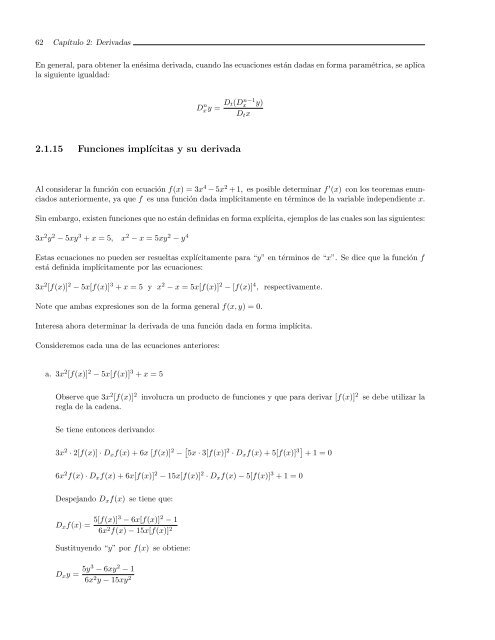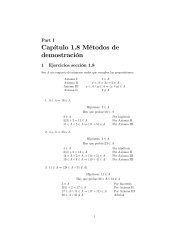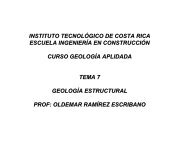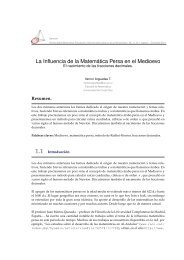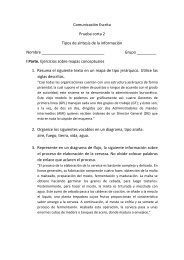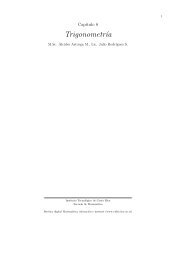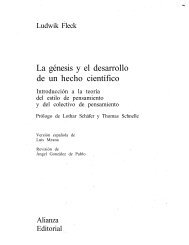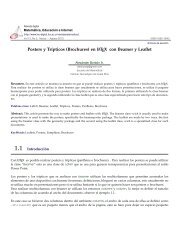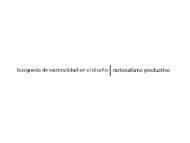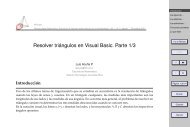Derivada de una función - TEC-Digital
Derivada de una función - TEC-Digital
Derivada de una función - TEC-Digital
Create successful ePaper yourself
Turn your PDF publications into a flip-book with our unique Google optimized e-Paper software.
62 Capítulo 2: <strong>Derivada</strong>s<br />
En general, para obtener la enésima <strong>de</strong>rivada, cuando las ecuaciones están dadas en forma paramétrica, se aplica<br />
la siguiente igualdad:<br />
D n xy =<br />
2.1.15 Funciones implícitas y su <strong>de</strong>rivada<br />
n−1 Dt(Dx y)<br />
Dtx<br />
Al consi<strong>de</strong>rar la <strong>función</strong> con ecuación f(x) = 3x 4 − 5x 2 + 1, es posible <strong>de</strong>terminar f ′ (x) con los teoremas enunciados<br />
anteriormente, ya que f es <strong>una</strong> <strong>función</strong> dada implícitamente en términos <strong>de</strong> la variable in<strong>de</strong>pendiente x.<br />
Sin embargo, existen funciones que no están <strong>de</strong>finidas en forma explícita, ejemplos <strong>de</strong> las cuales son las siguientes:<br />
3x 2 y 2 − 5xy 3 + x = 5, x 2 − x = 5xy 2 − y 4<br />
Estas ecuaciones no pue<strong>de</strong>n ser resueltas explícitamente para “y” en términos <strong>de</strong> “x”. Se dice que la <strong>función</strong> f<br />
está <strong>de</strong>finida implícitamente por las ecuaciones:<br />
3x 2 [f(x)] 2 − 5x[f(x)] 3 + x = 5 y x 2 − x = 5x[f(x)] 2 − [f(x)] 4 , respectivamente.<br />
Note que ambas expresiones son <strong>de</strong> la forma general f(x, y) = 0.<br />
Interesa ahora <strong>de</strong>terminar la <strong>de</strong>rivada <strong>de</strong> <strong>una</strong> <strong>función</strong> dada en forma implícita.<br />
Consi<strong>de</strong>remos cada <strong>una</strong> <strong>de</strong> las ecuaciones anteriores:<br />
a. 3x 2 [f(x)] 2 − 5x[f(x)] 3 + x = 5<br />
Observe que 3x 2 [f(x)] 2 involucra un producto <strong>de</strong> funciones y que para <strong>de</strong>rivar [f(x)] 2 se <strong>de</strong>be utilizar la<br />
regla <strong>de</strong> la ca<strong>de</strong>na.<br />
Se tiene entonces <strong>de</strong>rivando:<br />
3x 2 · 2[f(x)] · Dxf(x) + 6x [f(x)] 2 − 5x · 3[f(x)] 2 · Dxf(x) + 5[f(x)] 3 + 1 = 0<br />
6x 2 f(x) · Dxf(x) + 6x[f(x)] 2 − 15x[f(x)] 2 · Dxf(x) − 5[f(x)] 3 + 1 = 0<br />
Despejando Dxf(x) se tiene que:<br />
Dxf(x) = 5[f(x)]3 − 6x[f(x)] 2 − 1<br />
6x 2 f(x) − 15x[f(x)] 2<br />
Sustituyendo “y” por f(x) se obtiene:<br />
Dxy = 5y3 − 6xy 2 − 1<br />
6x 2 y − 15xy 2


